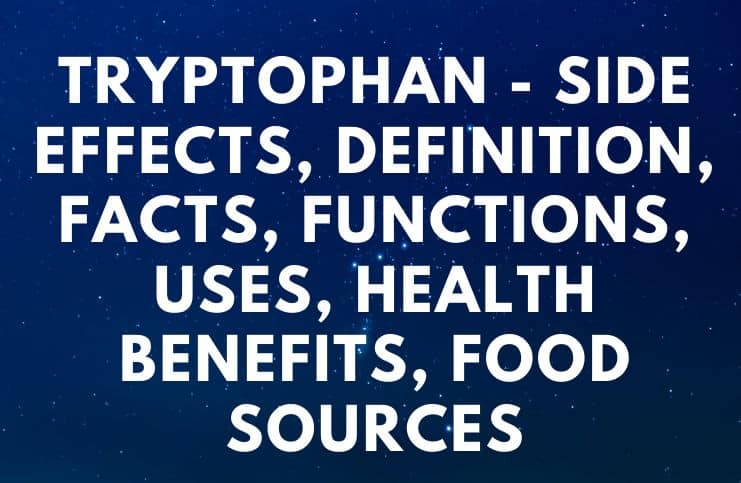Tryptophan – Side Effects & Health Benefits:
It was discovered in 1901 by Frederick Hopkins, and it belongs to the group of essential amino acids.
It is used by the brain, together with vitamin B6, nicotinamide, and magnesium, to produce serotonin – the substance carrying messages between the brain’s nerve cells.
Foods rich in this essential amino acid alone can not increase the level of serotonin in the brain.
In order to do this, it is necessary to eat 30-50 grams of carbohydrate-rich foods after dinner. Carbohydrates favor the transition of tryptophan from blood to the brain, where it can increase the level of serotonin, thus ensuring a peaceful sleep.
Functions and health benefits
It is a very good sedative and a natural antidepressant, with beneficial effects on the brain.
Its contribution to the increase of serotonin levels becomes a tool that helps relax the body, calm the nerves, increase efficiency in maintaining the health of body and mind, reduce chronic pains, and can positively influence obsessive, violent, and impulsive behavior, as well as addictions.
It reduces the appetite
Diets containing foods rich in this amino acid are recommended for healthy weight loss, because this amino acid decreases the appetite, by creating a sense of satiety and thus normalizing bulimia. Just like vitamin B3, this amino acid also helps slow the formation of fatty components (triglycerides) and hence leading to weight loss.
By producing serotonin, its effect is even more beneficial as it creates a state of well-being, thus ideal conditions in the body to continue the diet enthusiastically.
It reduces fat and increases muscle mass
This amino acid plays an important role in the treatment of conditions caused by diet, hyperactivity, and diseases manifested by nervous states. It has a soothing effect, reducing pain and bad emotional states. Also, it helps maintain a good physical condition by increasing muscle mass.
It is effective in premenstrual dysphoric disorder
Premenstrual dysphoric disorders are severe emotional disorders caused by the premenstrual syndrome, that can weaken the body due to the physical, mental, and emotional symptoms.
In a study conducted at St. Mary Hospital in Montreal, researchers have given 6 grams of this essential amino acid to patients suffering from premenstrual dysphoric disorder.
After only 17 days of treatment, starting from the ovulation period until the third day of menstruation, this amino acid has significantly improved the unpleasant symptoms caused by premenstrual syndrome.
It neutralizes the effect of nicotine
This amino acid is great for smokers and also for those who tend to drink too much alcohol, helping the body resist these harmful factors. It neutralizes bad moods caused by nicotine and reduces the symptoms that people with large amounts of alcohol in the blood experience.
It improves concentration and mental abilities
Supplements that contain this amino acid are the most effective for the body because foods alone contain small quantities of this amino acid. The recommended daily intake is 3.5 mg/kg body weight.
It is effective in cases of seasonal affective disorder (SAD)
The seasonal affective disorder is a disturbance of the normal condition and is experienced by people who do not have any kind of health problems. Its manifestation includes annual symptoms of winter depression, winter melancholy, or autumn depression.
Some people feel sad, others experience prolonged sleepiness, increased appetite, weight gain, or low libido. All these symptoms are linked to an increased synthesis of melatonin during winter.
In general, light inhibits the conversion of serotonin to melatonin.
Obviously, since the day is shorter and the night is longer, melatonin is synthesized faster, draining the serotonin reserves, leading to increased symptoms of seasonal affective disorder. Patients suffering from this condition tend to feel cravings for sweet and flour-based products, which generally happens when there are low serotonin levels in the body.
Researchers from the University of British Columbia have treated patients suffering from a seasonal affective disorder with 3 grams of this amino acid daily for two weeks. The results were very encouraging, as patients felt a significant reduction in the degree of their depression.
Food Sources
It is an essential amino acid and can be obtained only through food and nutritional supplements.
Animal and vegetable sources include:
- Meat: turkey, fish (salmon, carp, mackerel, caviar), and seafood.
- Dairy products.
- Grains and legumes: soy, oat, barley, millet, buckwheat, red kidney beans, lentils, navy beans, chickpeas, mung beans.
- Seeds and nuts: pistachios, chia seeds, peanuts, flax seeds, cashews, almonds, hazelnuts, sunflower seeds, walnuts, watermelon seeds, hemp seeds, and sesame seeds.
- Others: mushrooms, pasta, potatoes, sweet potatoes, dried apricots, bananas, and dates.
Side Effects of Tryptophan
Using dietary supplements containing this amino acid may lead to Serotonin Syndrome (symptoms include agitation, high body temperature, tremor, increased reflexes, dilated pupils, sweating, and diarrhea), which usually appears when individuals take some prescription medications which lead to high levels of serotonin.
More importantly, if you are ingesting supplements that have this amino acid for the 1st time, it is recommended to avoid taking them before engaging in any activity which needs mental alertness.
READ THIS NEXT:
Leucine – Health Benefits and Side Effects
Isoleucine – Health Benefits & Side Effects
Essential & Nonessential Amino Acids – Uses
References https://www.ncbi.nlm.nih.gov/pmc/articles/PMC4728667/ https://www.ncbi.nlm.nih.gov/pmc/articles/PMC4393508/
